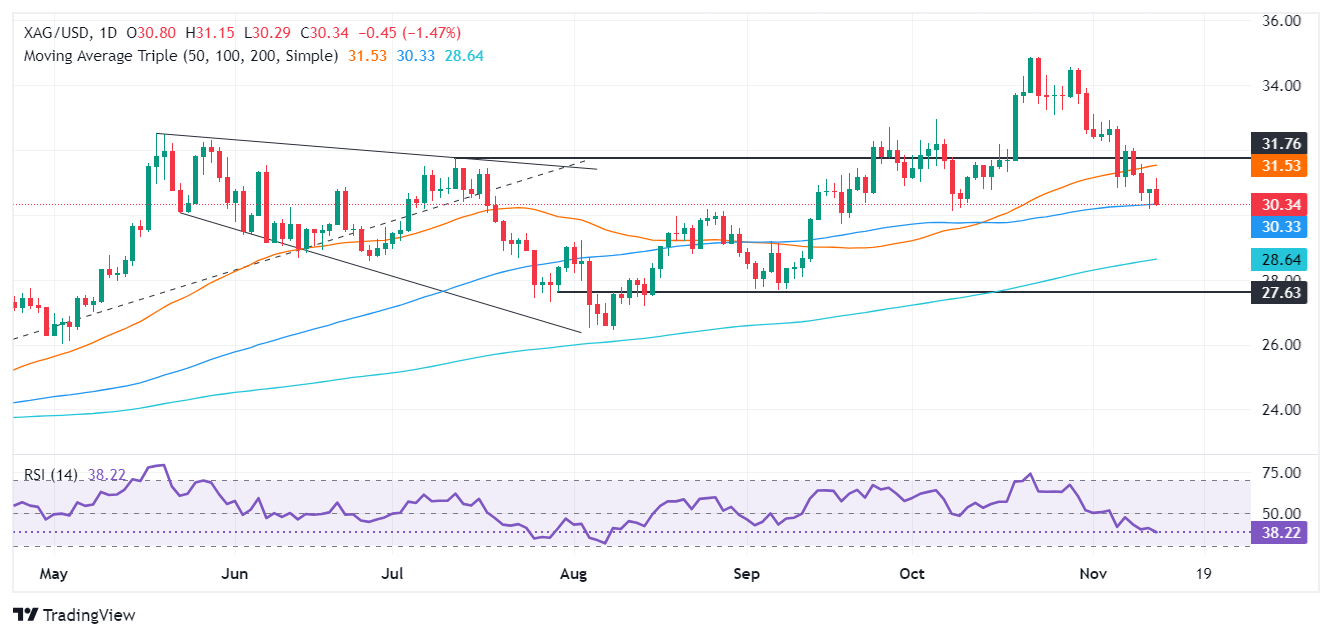- Silver struggles near 100-day SMA, with downside potential towards $30.00 and lower supports.
- Technical outlook suggests further weakness, with a key support at $30.18 and the 200-day SMA at $28.63 in focus.
- Recovery above $31.00 could challenge resistance at the 50-day SMA and extend towards $32.00.
Silver price drops below $30.50 for the second consecutive session, prints losses of over 0.90% following a tempered US inflation report. The US CPI came as expected, though he hinted that disinflation has stalled. The XAG/USD trades at $30.40, set to end the session lower.
XAG/USD Price Forecast: Technical outlook
Silver price consolidated during the last two days at around the 100-day Simple Moving Average (SMA) at $30.31. However, the mid-term bias is tilted to the downside, and once bears push prices below August’s 26 high turned support at $30.18, they will test the psychological $30.00 mark. A breach of the latter will expose the 200-day SMA at $28.63, followed by the September 6 swing low of $27.69.
If Silver moves back above $31.00, this could pave the way for challenging the 50-day SMA at $31.51. Once surpassed, XAG/USD's next resistance would be $32.00.
Oscillators like the Relative Strength Index (RSI) hint that further XAG/USD’s downside is seen, as RSI remains shy of being oversold.
XAG/USD Price Chart – Daily
Silver FAQs
Silver is a precious metal highly traded among investors. It has been historically used as a store of value and a medium of exchange. Although less popular than Gold, traders may turn to Silver to diversify their investment portfolio, for its intrinsic value or as a potential hedge during high-inflation periods. Investors can buy physical Silver, in coins or in bars, or trade it through vehicles such as Exchange Traded Funds, which track its price on international markets.
Silver prices can move due to a wide range of factors. Geopolitical instability or fears of a deep recession can make Silver price escalate due to its safe-haven status, although to a lesser extent than Gold's. As a yieldless asset, Silver tends to rise with lower interest rates. Its moves also depend on how the US Dollar (USD) behaves as the asset is priced in dollars (XAG/USD). A strong Dollar tends to keep the price of Silver at bay, whereas a weaker Dollar is likely to propel prices up. Other factors such as investment demand, mining supply – Silver is much more abundant than Gold – and recycling rates can also affect prices.
Silver is widely used in industry, particularly in sectors such as electronics or solar energy, as it has one of the highest electric conductivity of all metals – more than Copper and Gold. A surge in demand can increase prices, while a decline tends to lower them. Dynamics in the US, Chinese and Indian economies can also contribute to price swings: for the US and particularly China, their big industrial sectors use Silver in various processes; in India, consumers’ demand for the precious metal for jewellery also plays a key role in setting prices.
Silver prices tend to follow Gold's moves. When Gold prices rise, Silver typically follows suit, as their status as safe-haven assets is similar. The Gold/Silver ratio, which shows the number of ounces of Silver needed to equal the value of one ounce of Gold, may help to determine the relative valuation between both metals. Some investors may consider a high ratio as an indicator that Silver is undervalued, or Gold is overvalued. On the contrary, a low ratio might suggest that Gold is undervalued relative to Silver.
Information on these pages contains forward-looking statements that involve risks and uncertainties. Markets and instruments profiled on this page are for informational purposes only and should not in any way come across as a recommendation to buy or sell in these assets. You should do your own thorough research before making any investment decisions. FXStreet does not in any way guarantee that this information is free from mistakes, errors, or material misstatements. It also does not guarantee that this information is of a timely nature. Investing in Open Markets involves a great deal of risk, including the loss of all or a portion of your investment, as well as emotional distress. All risks, losses and costs associated with investing, including total loss of principal, are your responsibility. The views and opinions expressed in this article are those of the authors and do not necessarily reflect the official policy or position of FXStreet nor its advertisers. The author will not be held responsible for information that is found at the end of links posted on this page.
If not otherwise explicitly mentioned in the body of the article, at the time of writing, the author has no position in any stock mentioned in this article and no business relationship with any company mentioned. The author has not received compensation for writing this article, other than from FXStreet.
FXStreet and the author do not provide personalized recommendations. The author makes no representations as to the accuracy, completeness, or suitability of this information. FXStreet and the author will not be liable for any errors, omissions or any losses, injuries or damages arising from this information and its display or use. Errors and omissions excepted.
The author and FXStreet are not registered investment advisors and nothing in this article is intended to be investment advice.
Recommended content
Editors’ Picks

AUD/USD softens to near 0.6500 ahead of Australian Retail Sales data
The AUD/USD pair weakens to near 0.6510 despite the renewed US Dollar demand during the early Asian session on Monday. Investors will keep an eye on the Australian Retail Sales and the USISM Manufacturing Purchasing Managers' Index, which is due later on Monday.

USD/JPY rebounds from multi-week low amid renewed USD buying
USD/JPY stages a goodish recovery from over a one-month low set on Friday amid a pickup in the USD demand. Spot prices climb above 150.00, though the upside seems limited in the wake of rising bets for another interest rate hike by the BoJ this month. Furthermore, Trump's tariff threats and geopolitical risks could benefit the safe-haven JPY and cap the pair at the start of a critical week.

Gold holds below $2,650 on US Dollar rebound
Gold price edges lower to around $2,645 during the early Asian session on Monday. A recovery in the US Dollar broadly weighs on the precious metal. However, persistent geopolitical tensions could cap the downside for XAU/USD.

Week ahead: Traders lock gaze on NFP after Thanksgiving holiday
Will the NFP data corroborate bets of a Fed pause? Loonie traders await employment numbers as well. Australia’s GDP to verify whether bets of May RBA cut are realistic. Euro could take directions from ECB President Lagarde.

Eurozone PMI sounds the alarm about growth once more
The composite PMI dropped from 50 to 48.1, once more stressing growth concerns for the eurozone. Hard data has actually come in better than expected recently – so ahead of the December meeting, the ECB has to figure out whether this is the PMI crying wolf or whether it should take this signal seriously. We think it’s the latter.

Best Forex Brokers with Low Spreads
VERIFIED Low spreads are crucial for reducing trading costs. Explore top Forex brokers offering competitive spreads and high leverage. Compare options for EUR/USD, GBP/USD, USD/JPY, and Gold.
